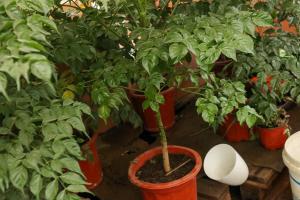Introduction:
Tomatoes are a popular crop among gardeners, but sometimes black spots can appear on their leaves. These spots can be a sign of several different ailments that can impact the health of the plant and the quality of the fruit. In this article, we will explore why black spots might appear on a tomato plant's leaves and what steps can be taken to treat or prevent them.
Causes:
One of the primary causes of black spots on tomato plant leaves is a fungal disease called early blight. This disease is caused by a fungus called Alternaria solani and is characterized by the appearance of small, dark spots on the leaves, which eventually turn yellow and fall off. Early blight is more common in humid conditions and can spread quickly throughout a garden.
Another potential cause of black spots on tomato leaves is a disease known as blossom-end rot. This condition is characterized by black or brown spots that appear on the bottom of the fruit and can spread to the leaves. It is caused by a lack of calcium in the soil, which can prevent the plant from absorbing enough nutrients to form healthy fruit.
Pests can also be a cause of black spots on tomato plant leaves. The tomato fruitworm, for example, can eat holes into the fruit and cause spotting on the leaves. Other pests, such as aphids and whiteflies, can cause yellowing and distortion of the leaves, which can lead to black spots.
Treatment:
The best way to treat black spots on tomato plant leaves depends on the cause of the problem. For early blight, the affected area of the plant should be removed and destroyed to prevent the disease from spreading. Fungicides can also be used to control the spread of the disease.
For blossom-end rot, the best treatment is to improve the quality of the soil by adding calcium-rich fertilizer or lime. Keeping the soil consistently moist, but not overly wet, can also help prevent this condition from occurring.
If pests are the cause of the black spots on tomato plant leaves, the plants should be treated with an appropriate pesticide. In some cases, removing the affected leaves or fruit can also help reduce pest populations.
Prevention:
Prevention is often the most effective way to deal with black spots on tomato plant leaves. Proper plant spacing, good ventilation, and regular pruning can help prevent the spread of fungal diseases like early blight.
Using high-quality soil, and regularly testing its nutrient levels, can help prevent conditions like blossom-end rot. Choosing disease-resistant tomato varieties and practicing crop rotation can also help prevent the spread of disease and pests.
Conclusion:
Black spots on tomato plant leaves can be a sign of several different ailments, but they can all impact the health of the plant and the quality of the fruit. Determining the cause of the black spots is crucial for proper treatment and prevention. Taking steps to prevent these problems from occurring in the first place can help ensure healthy tomato plants and abundant, high-quality fruit.

 how many times do yo...
how many times do yo... how many planted tre...
how many planted tre... how many pine trees ...
how many pine trees ... how many pecan trees...
how many pecan trees... how many plants comp...
how many plants comp... how many plants can ...
how many plants can ... how many plants and ...
how many plants and ... how many pepper plan...
how many pepper plan...































